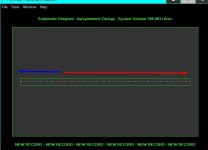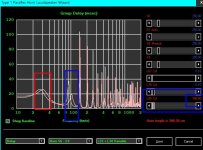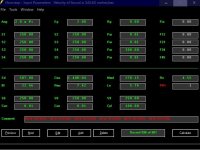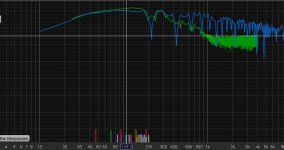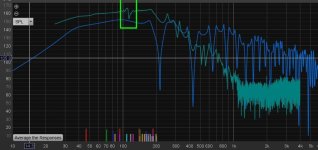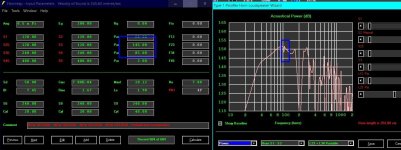What causes a drastic reduction in group delay by adding a 100cm pipe to an existing 300cm pipe (with exits connected)?
(pink is both, white is the plain 300cm TL)
both pipes are at velocity max for that resonace where they join? Instead of the single pipe venting onto the driver’90degrees‘ out of phase at resonance ?
(pink is both, white is the plain 300cm TL)
both pipes are at velocity max for that resonace where they join? Instead of the single pipe venting onto the driver’90degrees‘ out of phase at resonance ?
Attachments
You are going from a TL (fancy BR) to a BP6P enclosure when you start with a 300cm TL and add a 100cm section in front of the driver.
I like using feet instead of cm.








I like using feet instead of cm.
Should have went with 3ft instead of 4ft in front of the 10ft TL.
That -1 foot made a HUGE difference in GD.




That -1 foot made a HUGE difference in GD.
I guess you need to retract your statement in the other thread about 6th orders being garbage.
BP6P 6.55 m/s beats TL 13.98 m/s in GD.
BP6P 6.55 m/s beats TL 13.98 m/s in GD.
The real thing ….(amp has a -6dB filter at 200hz)
Horn response is blue and the parallel 6th order is measured in green. I used a 240 cm pipe connected at exit (PH1 mode) to an 80 cm pipe, kind of like paraflex I guess?
what’s happening at 108 hz(80 cm) In the waterfall chart?
Horn response is blue and the parallel 6th order is measured in green. I used a 240 cm pipe connected at exit (PH1 mode) to an 80 cm pipe, kind of like paraflex I guess?
what’s happening at 108 hz(80 cm) In the waterfall chart?
Attachments
Last edited:
If I move the mic back 20 cm into the long side pipe (kind if like you suggested with the length change ) The phase discontinuity begins to show up.
i wish I understood rew more and could look threw the rest of the info for impulse or group delay graphs?
i wish I understood rew more and could look threw the rest of the info for impulse or group delay graphs?
Attachments
Definitely not, you’re just sweeping through loudspeaker wizard for blips on the radar that momentarily ’look’ like less phase junk and not connecting resonators in places that the ‘phase’ is best aligned at the shared exit by the actual pressure/velocity of physics ?I guess you need to retract your statement in the other thread about 6th orders being garbage.
BP6P 6.55 m/s beats TL 13.98 m/s in GD.
It seems the fromt and rear waves must join ‘in phase‘ or at the ‘90 degree parts(nodes) of resonace‘ in 1/4 wave or these designs quickly produce very strange issues and it’s presented as the gouge in horn response in ph1 mode of anything is out of the 3:1 length of the resonace they both share?
(I dunno For sure, I’m just exploring this )
But it is intersting to ponder what is happening at your 4/4 and 1/4 frequency/wavelength connection ??? One is a full wave length and the other a 1/4 wavelegth between them Or their relationship at exit from each closed end of their respective resonaturs?
Last edited:
Guy, IT'S A SUBwoofer. You are LISTENING to 80hz and DOWN. Why care about what you are NOT listening to?
The real thing ….(amp has a -6dB filter at 200hz)
Horn response is blue and the parallel 6th order is measured in green. I used a 240 cm pipe connected at exit (PH1 mode) to an 80 cm pipe, kind of like paraflex I guess?
what’s happening at 108 hz(80 cm) In the waterfall chart?
A Paraflex is still a BP6. Due to the closeness of the 2 mouths, it's a BP6S that behaves like a BP6P.
MY SUBwoofer amplifier is not going to SEE 108hz so MY SUBwoofer enclosure is not going to SEE 108hz either.
if you pull the 108 hz out of paraflex with dsp (or any of the high tuned resonatur functions in the 3 xx Fb region) ) you remove it’s amazing punch and exciting sound.
i believe the same goes for the devestatir designs you are a big fan of as well?
i believe the same goes for the devestatir designs you are a big fan of as well?
I have to add ~5 cm to each fold to create the same issue in horn response
Still no concern to ME when I'm using an 80hz low pass filter.
You need to read some of the OG TH threads. Some these guys ran their TH's without LP filters and THEY say THEIR enclosures still sound good.
That's what the MIDBASS drivers (car audio) or surround speakers (home audio) are for.if you pull the 108 hz out of paraflex with dsp (or any of the high tuned resonatur functions in the 3 xx Fb region) ) you remove it’s amazing punch and exciting sound.
That’s the biggest issue with paraflex imho. It’s just an overdamped SUB woofer with a RealLY potent kick…. But holy moly does it kick! And ring 🥲
Definitely not, you’re just sweeping through loudspeaker wizard for blips on the radar that momentarily ’look’ like less phase junk and not connecting resonators in places that the ‘phase’ is best aligned at the shared exit by the actual pressure/velocity of physics ?
It seems the fromt and rear waves must join ‘in phase‘ or at the ‘90 degree parts(nodes) of resonace‘ in 1/4 wave or these designs quickly produce very strange issues and it’s presented as the gouge in horn response in ph1 mode of anything is out of the 3:1 length of the resonace they both share?
(I dunno For sure, I’m just exploring this )
But it is intersting to ponder what is happening at your 4/4 and 1/4 frequency/wavelength connection ??? One is a full wave length and the other a 1/4 wavelegth between them Or their relationship at exit from each closed end of their respective resonaturs?
I don't use the PH function in HR. Version 50.70 does not have it.
All I know is 10ft (304.80cm...similar to your 300cm) is usually the magic length for TH's...positive, straight, or negative flare.
That’s the biggest issue with paraflex imho. It’s just an overdamped SUB woofer with a RealLY potent kick…. But holy moly does it kick! And ring 🥲
I don't think you are getting the full benefit of a series tuned 6th order when you have the 2 mouths so close together.
Look at the Devastators (BP6P) thread on avsforum. They are SPECIFICALLY designed to have more MIDBASS kick, but still play down to 20hz. The killing part is, the people on the accept port velocities of 25 m/s.
I design my car audio BP4's like the Devastators. Perfectly flat 2Pi bandpass responses take away MIDBASS in an 0.5Pi environment. That's why I flipped my HT sub 180*. Yeah, it was cracking walls firing into the corner. But when I flipped it 180*, the MIDBASS kicked in.
Did the added path from the vent exit to the top of the box/back wall create another resonator(like roar) maybe ?
Do you have any devestatur sims that we could study by removing the Hugh tuned resonator in hornresponse and see what lines up in the impedance plot if anything? I wonder if those ring as crazy as ‘paraflex’ does (potentially)?I don't think you are getting the full benefit of a series tuned 6th order when you have the 2 mouths so close together.
Look at the Devastators (BP6P) thread on avsforum. They are SPECIFICALLY designed to have more MIDBASS kick, but still play down to 20hz. The killing part is, the people on the accept port velocities of 25 m/s.
I design my car audio BP4's like the Devastators. Perfectly flat 2Pi bandpass responses take away MIDBASS in an 0.5Pi environment. That's why I flipped my HT sub 180*. Yeah, it was cracking walls firing into the corner. But when I flipped it 180*, the MIDBASS kicked in.
- Home
- Loudspeakers
- Subwoofers
- Group delay in high order parallel
